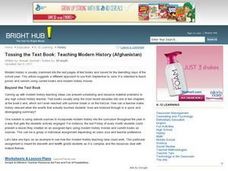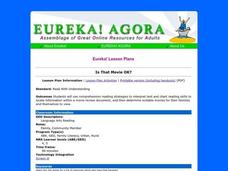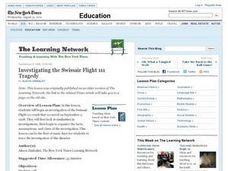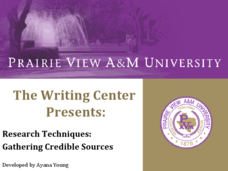Curated OER
Reading and Responding: Lesson 24
Fourth graders explore fictional literature. They read a fictional passage and practice answering multiple choice questions about the text they read. Students complete short answer questions.
Curated OER
Non-Fiction Animal Picture Books
Learners complete a multi-lesson unit using research to create their own book about an animal of their choice. After discussing the elements of non-fiction texts, they use internet research to explore an animal of interest to them. ...
Curated OER
Intermediate Level: Clauses and Sentence Structure
In this clauses and sentence structure worksheet, students read 5 sentences and underline the independent clauses and circle each dependent clause. Students then read 15 sentences and indicate if there are any grammatical errors.
Curated OER
Reading and Responding
Eighth graders read and respond to a poem. In this reading and responding lesson plan, 8th graders read a poem as a class and respond to questions about it.
Curated OER
Tossing the Text Book: Teaching Modern History
Tenth graders analyze primary sources. In this Current Events instructional activity, 10th graders write a short two - three paged paper answering a specific question. Students prepare a fact sheet for the class detailing...
Think Like A Programmer! Puzzlets Cork the Volcano Curriculum
Common Core Standards Connected
The standards listed below are standards from the Common Core Framework which map to learning opportunities with Cork The Volcano & Puzzlets.
Source Link:...
Achieve The Core
Linda R. Monk, Words We Live By: Your Annotated Guide to the Constitution - Grade 8
“We the people . . .” Thus begins the Preamble to the Constitution. Using a close reading approach, class members examine an excerpt from Linda Monk’s article that traces how the interpretation of these words has evolved. Some of your...
Hyperion Publishing
Words We Live By: Your Annotated Guide to the Constitution
The language of the Constitution can feel quite ominous to young learners, but there are a variety of strategies you can utilize to help your class grasp the important concepts and ideals in our nation's founding document. This lesson...
Curated OER
Is That Movie OK?
Discuss movies and movie enjoyment with your middle school language arts class. They interpret movie review information, determine appropriate movies, and then write film reviews to share with the class. Focus on using context clues to...
Education World
The African American Population in US History
How has the African American population changed over the years? Learners use charts, statistical data, and maps to see how populations in African American communities have changed since the 1860s. Activity modifications are included to...
It's About Time
Factors Affecting Population Size
How do we predict future population growth? Young researchers investigate various factors affecting the size of our population. As they calculate and interpret graphs to determine factors that could potentially affect increases...
It's About Time
Run and Jump
Has your class wondered how fast a human could run or how high they are capable of jumping? Help them understand these concepts as they explore acceleration and use an accelerometer to make semiquantitative measurements of acceleration...
Curated OER
Poetry: Walking With My Iguana
Bring a little excitement to your next poetry analysis lesson. Using the highly energetic poem "Walking With My Iguana," learners consider poem structure and rhyme. They listen to the poem, discuss the rhythm and tone with their...
It's About Time
A Moving Frame of Reference
We often remind pupils to cite their references, but this lesson helps them understand there are many frames of reference. Scholars experiment with throwing a ball straight up in the air and catching it. Then they must do it again...
Curated OER
Investigating the Swissair Flight 111 Tragedy
Middle schoolers read two articles about the same event: "Plane from J.F.K Crashes off Canada" from the New York Times and "No Survivors from Crash of Swissair Jetliner Off Nova Scotia" from the Associated Press. They then compare the...
Curated OER
Dr. Jekyll and Mr. Hyde: Request Strategy
Model for readers how to develop effective questions with a request strategy for questioning. Text-explicit, text-implicit, and experiential based questions are the focus. Step-by-step instructions are included for the strategy that...
Shmoop
ELA.CCSS.ELA-Literacy.L.9-10.1
If you're completely lost on what grammar you should cover for Common Core skill L.9-10.1, look here! You will find some ideas and examples on what to include, making sure your learners can master the skill. The multiple choice quiz is...
Curated OER
Life on the Ocean Floor
Why would water 2700 meters deep suddenly become warmer? Explore this and other ocean floor discoveries through this reading response worksheet. Scholars read information about the organisms discovered by Alvin, a deep-sea submersible....
Curated OER
Who Wrote That?
Students explore the Project Gutenberg website and conduct a webquest to answer questions about well known literature and authors.
Curated OER
Research Techniques: Gathering Credible Sources
How can you spot a credible source? What even makes a resource reliable in the first place? Answer some of these questions with this presentation. Although intended for higher education, this PowerPoint could be modified for middle...
Shmoop
ELA.CCSS.ELA-Literacy.W.9-10.7
Considering adding more research to your curriculum? Check out this idea. The assignment example, which connects to the Common Core, is written for a lesson on "The Scarlet Ibis." However, you could adapt the bigger idea to almost any...
Curated OER
Legends
Students are introduced to the topic of legends. Using the text of Irving's novels, they gather information on different cultures. They practice using new vocabulary and their listening skills. They retell the stories in chronlogical order.
Curated OER
Flipped: After Reading Strategy
Everyone can be an expert! After finishing Wendelin Van Draanen's book Flipped, divide your class into small groups. Then, assign each group a topic to become experts on. The resource suggests topics such as characters, themes, setting,...
Curated OER
Some see art, some see vandalism
Students employ a wide range of strategies as they write and use different writing process elements appropriately to communicate with different audiences for a variety of purposes. Students conduct research on issues and interests by...

























